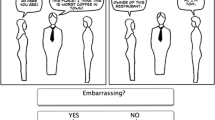Abstract
In the present study we introduce a sensitive video-based test for the evaluation of subtle mindreading difficulties: the Movie for the Assessment of Social Cognition (MASC). This new mindreading tool involves watching a short film and answering questions referring to the actors’ mental states. A group of adults with Asperger syndrome (n = 19) and well-matched control subjects (n = 20) were administered the MASC and three other mindreading tools as part of a broader neuropsychological testing session. Compared to control subjects, Asperger individuals exhibited marked and selective difficulties in social cognition. A Receiver Operating Characteristic (ROC) analysis for the mindreading tests identified the MASC as discriminating the diagnostic groups most accurately. Issues pertaining to the multidimensionality of the social cognition construct are discussed.

Similar content being viewed by others
References
American Psychiatric Association. (1994). Diagnostic and statistical manual of mental disorders (4th ed.). Washington, DC: American Psychiatric Association.
Asperger, H. (1944). Die “Autistischen Psychopathen” im Kindesalter. Archiv fur Psychiatrie und Nervenkrankheiten, 117, 76–136.
Baron-Cohen, S. (1992). Out of sight or out of mind? Another look at deception in autism. Journal of Child Psychology and Psychiatry, and Allied Disciplines, 33, 1141–1155.
Baron-Cohen, S. (1995). Mindblindness: An essay on autism and theory of mind. Cambridge, Massachusetts: MIT Press.
Baron-Cohen, S., Jolliffe, T., Mortimore, C., & Robertson, M. (1997). Another advanced test of theory of mind: Evidence from very high functioning adults with autism or asperger syndrome. Journal of Child Psychology and Psychiatry, 38, 813–822.
Baron-Cohen, S., Leslie, A. M., & Frith, U. (1985). Does the autistic child have a “theory of mind?”. Cognition, 21, 37–46.
Baron-Cohen, S., O’Riordan, M., Stone, V., Jones, R., & Plaisted, K. (1999). Recognition of faux pas by normally developing children and children with Asperger syndrome or high-functioning autism. Journal of Autism and Developmental Disorders, 29, 407–418.
Baron-Cohen, S., Wheelwright, S., Hill, J., Raste, Y., & Plumb, I. (2001). The “Reading the Mind in the Eyes” Test revised version: A study with normal adults, and adults with Asperger syndrome or high-functioning autism. Journal of Child Psychology and Psychiatry, and Allied Disciplines, 42, 241–251.
Baron-Cohen, S., Wheelwright, S., & Jolliffe, T. (1997). Is there a “language of the eyes”? Evidence from normal adults, and adults with autism or Asperger syndrome. Visual Cognition, 4, 311–331.
Baron-Cohen, S., Wheelwright, S., Skinner, R., Martin, J., & Clubley, E. (2001). The autism-spectrum quotient (AQ): Evidence from Asperger Syndrome/High-Functioning Autism, males and females, scientists and mathematicians. Journal of Autism and Development Disorders, 31, 5–17.
Bowler, D. M. (1992). “Theory of mind” in Asperger’s syndrome. Journal of Child Psychology and Psychiatry, and Allied Disciplines, 33, 877–893.
Brothers, L. (1990). The social brain: A project for integrating primate behavior and neurophysiology in a new domain. Concepts in Neuroscience, 1, 27–51.
Dyck, M. J., Ferguson, K., & Shochet, I. M. (2001). Do autism spectrum disorders differ from each other and from non-spectrum disorders on emotion recognition tests? European Child & Adolescent Psychiatry, 10, 105–116.
Ekman, P. (1999). Basic Emotions. In T. Dalgleish & M. Power (Eds.), Handbook of cognition and emotion. Sussex, UK: John Wiley & Sons.
Ekman, P., & Friesen, W. (1971). Constants across cultures in the face and emotion. Journal of Personality and Social Personality, 17, 124–129.
Field, S., Meyer, A., & Witte, G. (2001). Drehbuchschreiben für Fersehen und Film. München: Ullstein Verlag.
Fleck, S., Dziobek, I., Rogers, K., Kalbe, E., Kessler, J., Mielke, R., Daum, I., Wolf, O. T., & Convit, A. (in preparation). MASC-MC. The Movie for the Assessment of Social Cognition in a new multiple choice answer format: A study with adults with Asperger syndrome.
Frith, U., & Happé, F. (1994). Autism: Beyond “theory of mind”. Cognition, 50, 115–132.
Grossman, J. B., Klin, A., Carter, A. S., & Volkmar F. R. (2000). Verbal bias in recognition of facial emotions in children with Asperger syndrome. Journal of Child Psychology and Psychiatry, and Allied Disciplines, 41, 369–379.
Happé, F. (1993). Communicative competence and theory of mind in autism: A test of relevance theory. Cognition, 48, 101–119.
Happé, F. (1994). An advanced test of theory of mind: Understanding of story characters’ thoughts and feelings by able autistic, mentally handicapped, and normal children and adults. Journal of Autism and Developmental Disorders, 24, 129–154.
Happé, F., Winner, E., & Brownell, H. (1998). The getting of wisdom: Theory of mind in old age. Developmental Psychology, 34, 358–362.
Heavey, L., Phillips, W., Baron-Cohen, S., & Rutter, M. (2000). The Awkward Moments Test: A naturalistic measure of social understanding in autism. Journal of Autism and Developmental Disorders, 30, 225–236.
Hobson, R. P., Ouston, J., & Lee, A. (1988). What’s in a face? The case of autism. The British Journal Of Psychology, 79(Pt 4), 441–453.
Horn, W. (1962). Leistungsprüfsystem: LPS. Göttingen: Hogrefe.
Howlin, P. (2003). Outcome in high-functioning adults with autism with and without early language delays: Implications for the differentiation between autism and Asperger syndrome. Journal of Autism and Developmental Disorders, 33, 3–13.
Hughes, C., Russell, J., & Robbins, T. W. (1994). Evidence for executive dysfunction in autism. Neuropsychologia, 32, 477–492.
Jolliffe, T., & Baron-Cohen, S. (1999). The Strange Stories Test: A replication with high-functioning adults with autism or Asperger syndrome. Journal of Autism and Developmental Disorders, 29, 395–406.
Kaland, N., Moller-Nielsen, A., Callesen, K., Mortensen, E. L., Gottlieb, D., & Smith, L. (2002). A new ‘advanced’ test of theory of mind: Evidence from children and adolescents with Asperger syndrome. Journal of Child Psychology and Psychiatry, and Allied Disciplines, 43, 517–528.
Kalbe, E., Fleck, S., Brand, M., Dziobek, I., Ruhrmann, S., & Kessler, J. (in preparation). “Too much ToM” in schizophrenic patients? Or: The necessity to differentiate the concept of Theory of Mind (ToM) and its disturbances.
Kalbe, E., Brand, M., Fleck, S., & Kessler, J. (2002). A differentiation of the construct of Theory of Mind: Theoretical considerations, corresponding tests, and preliminary data [Zur Fraktionierung des ToM-Konstrukts: theoretische Ueberlegungen, Testverfahren und erste Ergebnisse]. In M. Baumann, A. Keinath & J. F. Krems (Eds.), Experimentelle Psychologie. Abstracts der 44. Tagung experimentell arbeitender Psychologen. Regensburg: S. Roderer Verlag.
Kleinman, J., Marciano, P. L., & Ault, R. L. (2001). Advanced theory of mind in high-functioning adults with autism. Journal of Autism and Developmental Disorders, 31, 29–36.
Klin, A., & Volkmar, F. R. (1997). Asperger Syndrome. In D. J. Cohen & F. R. Volkmar (Eds.), Handbook of autism and pervasive developmental disorders (pp. 94–122). New York: John Wiley & Sons.
Lord, C., Rutter, M., & Le Couteur, A. (1994). Autism diagnostic interview-revised: A revised version of a diagnostic interview for caregivers of individuals with possible pevasive developmental disorders. Journal of Autism and Developmental Disorders, 24, 659–685.
Loveland, K., Tunali-Kotoski, B., Chen, R., Brelsford, K., & Ortegon, J. (1995). Intermodal perception of affect by persons with autism or Down syndrome. Development and Psychopathology, 7, 409–418.
Macdonald, H., Rutter, M., Howlin, P., Rios, P., Le Conteur, A., Evered, C., & Folstein, S. (1989). Recognition and expression of emotional cues by autistic and normal adults. Journal of Child Psychology and Psychiatry, and Allied Disciplines, 30, 865–877.
Njiokiktjien, C., Verschoor, A., de Sonneville, L., Huyser, C., Op het Veld, V., & Toorenaar, N. (2001). Disordered recognition of facial identity and emotions in three Asperger type autists. European Child & Adolescent Psychiatry, 10, 79–90.
Nunnally, J. C. (1978). Psychometric theory. New York: McGraw-Hill.
Ozonoff, S., Rogers, S. J., & Pennington, B. F. (1991). Asperger’s syndrome: Evidence of an empirical distinction from high-functioning autism. Journal of Child Psychology and Psychiatry, and Allied Disciplines, 32, 1107–1122.
Pelphrey, K. A., Sasson, N. J., Reznick, J. S., Paul, G., Goldman, B. D., & Piven, J. (2002). Visual scanning of faces in autism. Journal of Autism and Developmental Disorders, 32, 249–261.
Pilowsky, T., Yirmiya, N., Arbelle, S., & Mozes, T. (2000). Theory of mind abilities of children with schizophrenia, children with autism, and normally developing children. Schizophrenia Research, 42, 145–155.
Prado, W. M., & Taub, D. V. (1966). Accurate predication of individual intellectual functioning by the Shipley-Hartford. Journal of Clinical Psychology, 22, 294–296.
Prior, M., Dahlstrom, B., & Squires, T. L. (1990). Autistic children’s knowledge of thinking and feeling states in other people. Journal of Child Psychology and Psychiatry, and Allied Disciplines, 31, 587–601.
Reed, T., & Peterson, C. (1990). A comparative study of autistic subjects’ performance at two levels of visual and cognitive perspective taking. Journal of Autism and Developmental Disorders, 20, 555–567.
Reitan, R. M., & Wolfson, D. (1993). The Halstead Reitan Neuropsychological Test Battery: Theory and clinical interpretation. Tuscon, AZ: Neuropsychology Press.
Roeyers, H., Buysse, A., Ponnet, K., & Pichal, B. (2001). Advancing advanced mind-reading tests: Empathic accuracy in adults with a pervasive developmental disorder. Journal of Child Psychology and Psychiatry, and Allied Disciplines, 42, 271–278.
Rutherford, M. D., Baron-Cohen, S., & Wheelwright, S. (2002). Reading the mind in the voice: A study with normal adults and adults with Asperger syndrome and high functioning autism. Journal of Autism and Developmental Disorders, 32, 189–194.
Scott, D. W. (1985). Asperger’s syndrome and non-verbal communication: A pilot study. Psychological Medicine, 15, 683–687.
Stroop, J. R. (1935). Studies of interference in serial verbal reactions. Journal of Experimental Psychology: Learning, Memory and Cognition, 18, 643–662.
Teunisse, J. P., & de Gelder, B. (2003). Face processing in adolescents with autistic disorder: The inversion and composite effects. Brain and Cognition, 52, 285–294.
Volkmar, F. R., Klin, A., Schultz, R. T., Rubin, E., & Bronen, R. (2000). Asperger’s disorder. The American Journal of Psychiatry, 157, 262–267.
Wechsler, D. (1955). Wechsler adult intelligence scale. New York: Psychological Corporation.
Wechsler, D. (1987). Wechsler memory scale-revised. San Antonio: Psychological Corporation/Harcourt Brace Javanovich.
Wimmer, H., & Perner, J. (1983). Beliefs about beliefs: Representation and constraining function of wrong beliefs in young children’s understanding of deception. Cognition, 13, 103–128.
Wing, L. (1997). Syndromes of autism and atypical development. In D. J. Cohen & F. R. Volkmar (Eds.), Handbook of autism and pervasive developmental disorders (pp. 148–170). New York: John Wiley.
Zachary, R. A., Paulson, M. J., & Gorsuch, R. L. (1985). Estimating WAIS IQ from the Shipley Institute of Living Scale using continuously adjusted age norms. Journal of Clinical Psychology, 41, 820–831.
Acknowledgments
This research was funded by a grant from the National Alliance for Autism Research (NAAR). It was completed partially toward the first author’s Ph.D. dissertation at the University Bielefeld, which was supported with a training grant by the Cusanuswerk, Germany. The development of the MASC was, in part, supported by the Max-Planck-Institute for Neurological Research and Köln Fortune, Cologne, Germany. We are grateful to the participants and their families for volunteering for the study and we thank the great number of people who donated their time and dedication to the project. Our special thanks goes to Jonathan Bepler.
Author information
Authors and Affiliations
Corresponding author
Appendices
Appendix
Example scene and scoring criteria:
Scene 20:
Question: Why is Sandra asking this?
Examples for correct answers: To change to the topic that Cliff talked about before so that he gets involved again; to redirect the conversation to Cliff; to integrate Cliff; to reconnect with Cliff.
Examples for incorrect answers: To hear if Michael also has something interesting to say about Sweden; to see which of the two guys has a cooler story to tell; to see if Michael can corroborate Cliff’s story; she liked the Sweden topic better than the current one; to compare the two; to loosen Michael up, the Sweden topic also worked for Cliff.
Rights and permissions
About this article
Cite this article
Dziobek, I., Fleck, S., Kalbe, E. et al. Introducing MASC: A Movie for the Assessment of Social Cognition. J Autism Dev Disord 36, 623–636 (2006). https://doi.org/10.1007/s10803-006-0107-0
Published:
Issue Date:
DOI: https://doi.org/10.1007/s10803-006-0107-0







